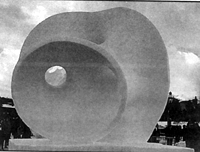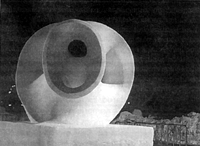Minimal Till It Melts
March 22, 1999

Barry A. Cipra
They didn't take a prize, but a team of mathematicians had one of the more novel entries in a snow-sculpting competition held this January in Breckenridge, Colorado. Helaman Ferguson, who is better known for his "theorems" in stone and bronze, and teammates Stan Wagon, Dan Schwalbe, and Tamas Nemeth from Macalester College in St. Paul, Minnesota, carved out a 12-foot-tall display of negative curvature known as the Costa surface, the first in a series of examples of mathematical minimalism discovered in the 1980s.
One of 16 teams chosen for the annual event, the mathematicians were competing against some of the world's best snow-sculptors. "We were very honored to get in," Ferguson says. Each team started with a 10 � 10 � 12-foot block of snow weighing approximately 20 tons. The sculpting took place over a five-day period, ending January 23. Ferguson estimates that the group removed nearly 15 tons of snow to create their entry.
Titled "Invisible Handshake," the sculpture centers on the intertwining tunnels of the Costa surface. The title derives from the fact that the empty space around the Costa surface is topologically similar to the space between two hands that are about to meet. The Costa surface was discovered in 1984 by Brazilian mathematician Celso Costa. It belongs to the class of unbounded "minimal" surfaces.
A minimal surface has the property that any small distortion can only increase its surface area. Minimal surfaces with boundaries are a dime a dozen-almost any closed curve (in 3-space) surrounds something of smallest area-but unbounded minimal surfaces are harder to come by. Until the 1980s, mathematicians knew of just three examples that didn't sport either self-intersections (which are generally viewed as undesirable) or infinitely many "holes"---and one of them was the trivial, flat plane. Then Costa proposed equations for a new minimal surface with just one topological hole and three punctures---a triply punctured torus.
It wasn't clear from the equations, however, whether Costa's new surface had self-intersections. The key to proving that it does not was discovered by David Hoffman, Jim Hoffman, and Bill Meeks of the University of Massachusetts. In an early success for computer visualization, they studied com-puter-generated pictures of the Costa surface and spotted symmetries that are not obvious in the equations; these symmetries sufficed to demonstrate the absence of self-intersections.
The Costa surface turned out to be the first in an infinite family of new minimal surfaces. Beyond their mathematical significance, these surfaces seem to possess intrinsic aesthetic appeal. Their sleek curvature would have appealed to Brancusi, and in their complex topology they echo the work of Henry Moore.
Curvature was the key to rendering the Costa surface in snow, Ferguson says. Like all minimal surfaces (except the plane), the Costa surface has negative curvature at every point: If the surface curves up in one direction, it curves down in the perpendicular direction, like the seat of a saddle. This is significant structurally, because it implies that at least some of the sculpture's weight is transmitted as a compressive force at essentially every point. That's especially important in snow-sculpting, because snow is very strong with respect to compressive force (witness the igloo) and rather weak with respect to tensile force. The intrinsic strength of the Costa surface allowed Ferguson's team to make their "surface" surprisingly thin: In places it was a mere 3 or 4 inches thick.
Ferguson, who doesn't usually work with material that melts, points out that it was Wagon's idea to enter the snow-sculpting competition. "I told him I did granite, I didn't do snow," Ferguson recalls. But the idea intrigued the mathematician-sculptor, so last May he did a small practice piece in his backyard to see how the snow ("zamboni" snow-ice shavings from the arena where the Washington Capitals hockey team practices) would hold up. "I got a few cubic feet of snow and went at it with a big kitchen spoon and spatula," he says.
The existence proof was successful.
"It was the strangest thing," Ferguson says. Despite the warmth, his miniature minimal surface held up. "The walls got thinner and thinner, but they stood up. . . . It was pretty amazing."
Although the awards at Breckenridge went to more conventional designs, the mathematicians' entry was a big hit with local schoolchildren, who were fascinated by the holes. The sculptors invited the children to climb on the piece while it was still being roughed out.

"Invisible Handshake," scuplted from a 20-ton block of snow by a team of four mathematicians. (Photographs by Claire Ferguson.)
"There was a period of time when we had about 50 kids climbing on the sculpture," Ferguson recalls. "That was probably the best thing about the piece!"
The mathematical minimalists may make Breckenridge an annual event. Although he still prefers the lasting nature of bronze and stone, Ferguson says he's intrigued by the unusual properties of snow. Questioned about plans for any big projects in ice or snow, he asks, only half jokingly, "Do you know of any good glaciers?"
Barry A. Cipra is a mathematician and writer based in Northfield, Minnesota.

